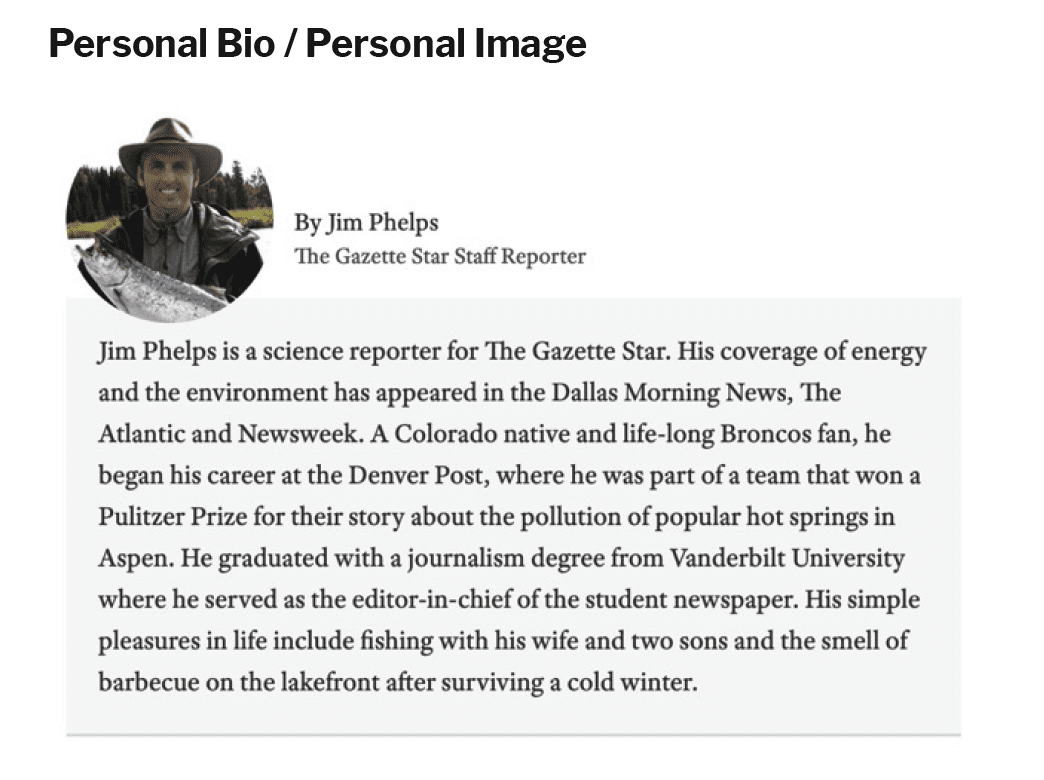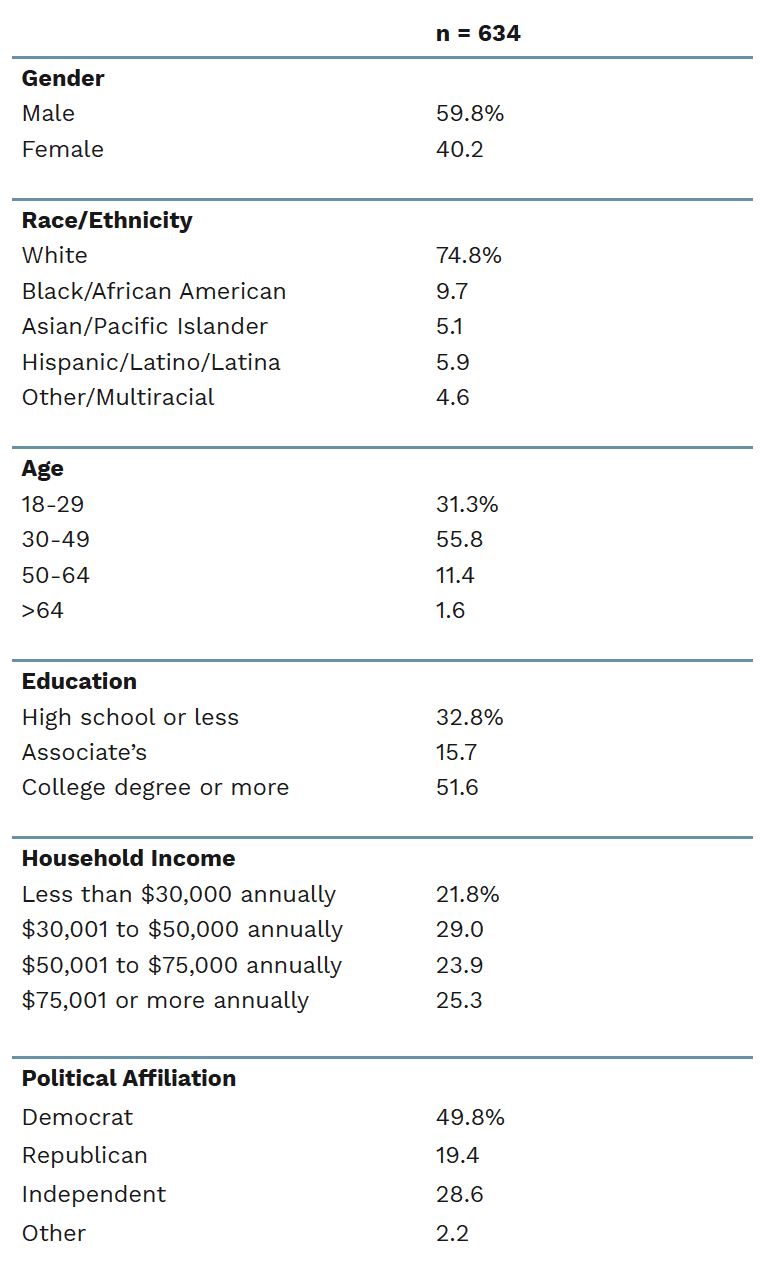
The Center for Media Engagement previously found that using multiple trust strategies in a news article, including reporter biographies, can positively affect readers’ trust in and engagement with news. In this study, we explored how biographies alone influence readers’ perceptions of reporters and news organizations.
We found that readers were equally engaged and expressed similar levels of trust in the reporter and the news organization regardless of whether the biographies were present and irrespective of whether the biographies were more personal or professional. However, readers did feel they knew the reporter better after reading a biography with a personal photo and personal details.
The Problem
News organizations approach journalists’ biographies in many different ways. Some news organizations do not link to biographies of their reporters in news articles. Some outlets, like KPRC 2 in Houston, have elaborate biography pages for their reporters. In order to see what value reporter biographies might bring, the Center for Media Engagement, with funding from the Democracy Fund, tested whether biographies make a difference in the way readers view the reporter and the news organization. We also examined whether using a personal image versus a professional headshot and including personal information in the biography text, such as hobbies and family details, influenced readers’ perceptions.
Key Findings
- When readers saw a biography that contained both a personal photo and personal details about the reporter, they felt they knew the reporter better than those who saw any other type of biography.
- Reading a specific type of biography, or even seeing a biography at all, didn’t significantly affect readers’ views of the article, the reporter, or the news organization.
Implications for Newsrooms
Using a personal photo and including personal details in a reporter’s biography made participants feel they knew the reporter better, but this feeling didn’t influence readers’ attitudes about a news organization more broadly. This suggests that providing journalist biographies isn’t enough to boost trust and engagement when used alone. This doesn’t mean newsrooms should completely discount using biographies, however. Using a personal photo and sharing personal details in a biography could be a way to humanize reporters and make connections with readers. It’s also possible that other combinations of trust and transparency measures could be effective in tandem with biographies to boost trust and engagement. Newsrooms should try using reporter biographies in combination with other trust strategies, which we found to be effective.
The Study
For this experiment, we created biographies for a mock reporter from a mock news site called The Gazette Star. Participants were asked to read:
- A biography with a personal image and personal details,
- A biography with a professional image and personal details,
- A biography with a personal image and no personal details,
- A biography with a professional image and no personal details, or
- No biography at all.
After reading a version of the biography, participants were asked to read a science article about “superbugs,” or antibiotic-resistant bacteria. The article was accompanied by the same biography that participants had seen previously. Those who were in the control group (no biography) proceeded straight to a version of the article that featured a traditional byline and no picture or other information about the journalist.
Participants who read a biography were asked how well they thought they knew the reporter personally on a scale of 1 (not at all well) to 4 (very well). Readers who saw a biography that contained both a personal photo and personal details about the reporter felt they knew the reporter better than those who saw any other type of biography.1
However, participants’ attitudes toward the reporter, the article, and the news organization were unaffected by the presence of a biography or the type of biography.2
There was a slight indication that the professional biography and professional image, compared to no biography, made people less likely to think that the reporter was like them. This difference was not statistically significant, however.3
Methodology
We recruited 634 participants from TurkPrime, an online platform that draws participants from Amazon’s Mechanical Turk. The experiment was embedded in a Qualtrics-based online survey.
We tested for differences using ANOVA. All results were controlled for level of trust in news,4 as there were significant differences between the groups in different conditions.5 There were no significant differences between conditions for any other demographic factors.6,7,8,9,10,11
Participant Demographics
SUGGESTED CITATION:
Murray, Caroline and Stroud, Natalie Jomini. (2020, February). Reporter Bios Alone Aren’t Enough to Boost Trust. Center for Media Engagement. https://mediaengagement.org/research/reporter-bios-and-trust/
- We tested for differences using ANOVA. There was a significant effect of condition F(3, 503) = 6.18, p > .05. Post-hoc comparisons show significant differences between those who saw a personal biography with a personal image and any other group that saw a biography. [↩]
- Post-hoc power analyses indicate that with a sample of this size, we would be able to detect differences with an effect size of 0.14 or greater with power of 0.8. Effects sizes of 0.10 are considered small, 0.25 considered medium, and 0.40 considered large. [↩]
- ANOVA produced a marginally significant difference between conditions F(4, 632) = 2.37, p=0.52. Post-hoc tests showed a significant difference between the participants who saw a professional biography and professional photo and those who saw no biography at all (p < 0.05). [↩]
- Trust in news was calculated by averaging participants’ ratings of two statements on a 1 (strongly disagree) to 7 (strongly agree) scale: “I think you can trust most news most of the time” and “I think I can trust most of the news that I consume most of the time.” Responses to the two statements were highly correlated, r = .853, p < .001. [↩]
- If we run the analysis without controlling for trust in news, there is only one change in the results: there is no longer a significant difference in the ratings of how well participants felt like they knew the reporter between the group who saw a personal biography and personal photo and the group who saw a personal biography and professional photo. No other results in this report change. [↩]
- On a scale of 1 (strongly disagree) to 7 (strongly agree), participants were asked to rate three statements: “The Gazette Star reporter carefully researched this article,” “The author of this article was well-qualified to write it” and “The Gazette Star reporter has high expectations for their reporting.” We combined the ratings into a single variable to test for differences (Cronbach’s alpha: 0.801). We tested for differences using ANOVA. There was no significant effect of condition F(4, 633) = 0.645, p > .05. [↩]
- On a scale of 1 (strongly disagree) to 7 (strongly agree), participants were asked to rate a series of statements related to The Gazette Star’s level of trustworthiness and transparency. We combined these ratings into a single variable to test for differences (Cronbach’s alpha: 0.885). We tested for differences using ANOVA. There was no significant effect of condition F(4, 633) = 0.416, p > .05. [↩]
- On a scale of 1 (strongly disagree) to 7 (strongly agree), participants were asked how well a series of positive adjectives (Full list: interesting, engaging, unbiased, transparent, credible, trustworthy, well-written, informative, accurate) applied to the news article. We combined the positive adjectives into a single variable to test for differences (Cronbach’s alpha: 0.881). We tested for differences using ANOVA. There was no significant effect of condition F(4, 633) = 0.380, p > .05. [↩]
- On a scale of 1 (extremely unlikely) to 7 (extremely likely), participants were asked to rate how likely they were to take certain actions after reading the article, including following the journalist on social media, reading more articles from The Gazette Star and talking to others about the article. We combined these ratings into a single variable to test for differences (Cronbach’s alpha: 0.883). We tested for differences using ANOVA. There was no significant effect of condition F(4, 633) = 0.343, p > .05. [↩]
- We tested for differences using ANOVA. There was no significant effect of condition F(4, 632) = 1.88, p > .05. [↩]
- See footnote 3. [↩]








